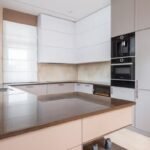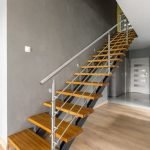What color walls go with an industrial home decor? This is a question that has been on the minds of many homeowners and interior design enthusiasts lately. With the growing popularity of industrial home decor, it has become increasingly important to choose the right wall color to enhance the overall look and feel of this style.
Industrial home decor is all about embracing raw aesthetics, incorporating elements like exposed brick walls, metal accents, and vintage furniture. The right wall color can make or break this aesthetic, setting the tone for an entire space. Throughout this blog post, we will delve into various colors that complement an industrial home decor and help create a cohesive look.
So whether you’re interested in going for a timeless appeal with exposed brick walls or want to invoke elegance with neutral tones, there’s a wall color option out there that will enhance your industrial design. Stick around as we explore different wall colors, discuss their impact on the overall ambiance, and provide tips for incorporating them seamlessly into your industrial haven.
Let’s dive in and discover the perfect wall color to set the tone for your industrial home decor.
Embracing the Raw Aesthetic
Exposed brick walls are a hallmark of industrial home decor, exuding a raw and rugged charm that instantly adds character to any space. The timeless appeal of exposed brick lies in its ability to evoke an industrial aesthetic that harkens back to the roots of this design style.
Whether you have original exposed brick or decide to create the look with faux brick panels, it is important to choose the right wall colors that enhance the texture and warmth of the bricks.
Bare or weathered: The choice is yours
One of the advantages of exposed brick walls is their versatility when it comes to finishing. Some homeowners prefer the stripped-down, authentic look of bare brick walls, allowing them to be true focal points in an industrial space. However, if you’re looking for a weathered appearance or want to seal your bricks for maintenance purposes, adding a clear sealant can help achieve this desired aesthetic while also protecting the bricks over time.
Complementary wall colors
When selecting wall colors to complement exposed brick, it’s important to consider enhancing both its texture and warmth. Neutral tones often work well as they provide a subtle backdrop without detracting from the charm of the bricks themselves.
Colors such as warm gray, beige, and taupe can enhance the natural beauty of exposed brick while maintaining a sophisticated industrial ambiance. These neutral shades also serve as a great foundation for other industrial decor elements such as metal accents and vintage furniture.
Adding pops of color
While neutrals are commonly used in industrial design, don’t be afraid to add pops of color through accent walls or colorful furniture pieces against your exposed brick backdrop. Bold hues like deep reds or blues can bring energy and vibrancy into an industrial space without overpowering its raw aesthetic. The key is finding a balance between muted tones and bold statements so that your color choices complement rather than compete with your exposed brick walls.
Whether you’re opting for the timeless appeal of bare brick or adding a clear sealant for a weathered look, exposed brick walls are a versatile and striking feature in industrial home decor. By choosing the right complementary wall colors, you can enhance the texture and warmth of your bricks while maintaining an overall cohesive aesthetic.
The following sections will explore other wall color options that also work well in industrial interiors, continuing to guide you on your journey towards perfecting your industrial haven.
Invoking Elegance
In industrial home decor, there is a certain power and sophistication that comes with using neutral wall colors. Neutrals help to maintain the balance between the rawness of the industrial aesthetic and a refined elegance. Gray, beige, and taupe are popular choices that can enhance the overall ambiance of an industrial space.
One of the advantages of using neutral wall colors in an industrial setting is their ability to complement metal accents and vintage furniture. The soft tones of gray, beige, and taupe act as a neutral canvas, allowing these elements to stand out without overwhelming the space. Consider pairing charcoal gray walls with sleek chrome lighting fixtures or a beige accent wall with a distressed leather sofa for a cohesive look.
When incorporating neutral shades into your industrial decor, it’s important to pay attention to undertones. Grays can have warm or cool undertones, so choose one that complements other features in your space. Beige can range from warm sandy tones to cooler greige hues, allowing you to select a shade that works best with your existing color scheme. Taupe is known for its versatility and works well with both warm and cool accents.
To maximize the impact of neutral walls in an industrial space, play with different textures. Consider adding texture through exposed brick walls or vintage wood paneling for added visual interest. This combination of texture and color will create depth in your decor while maintaining an elegant ambiance.
By embracing a neutral palette for your walls in an industrial home decor style, you can achieve a timeless elegance that enhances the overall aesthetic of the space. Don’t be afraid to experiment with different shades of gray, beige, and taupe to find the perfect balance that suits your personal style and desired atmosphere.
Bold Statements
Dark and moody walls can make a powerful statement in industrial home decor, creating an intimate and mysterious atmosphere. Deep shades like charcoal, navy, and dark green are perfect for adding depth and drama to your space. Whether you choose to paint all the walls in a room or create an accent wall, dark colors can be used strategically to enhance the industrial aesthetic.
One advantage of using dark walls in industrial design is that they can provide a striking contrast against metal accents and vintage furniture. The richness of dark colors allows these elements to stand out and become the focal point of the room. For example, pairing a deep charcoal wall with a sleek metal shelving unit or a vintage leather sofa creates a visually captivating combination that exudes sophistication.
When choosing wall colors for an industrial interior with dark and moody walls, it’s important to consider the overall color scheme. While it may be tempting to go completely dark, incorporating lighter tones can help balance the space and prevent it from appearing too heavy or oppressive. For instance, light gray or creamy white ceilings and trim can provide a crisp contrast against the dark walls while maintaining the industrial ambiance.
In addition to creating depth and contrast, darker hues also have the power to amplify other industrial decor elements. Exposed pipes or ductwork can be emphasized by painting them in the same deep color as the walls, creating a seamless integration within the overall design. Additionally, artwork or decorative objects in bright primary colors can pop against dark walls, adding vibrant accents that energize the space.
Overall, incorporating dark and moody walls into your industrial home decor allows for bold statements that command attention. By carefully selecting complementary colors and balancing them with lighter tones throughout the space, you can create a cohesive look that is both dramatic and sophisticated. Don’t be afraid to experiment with different shades and textures to find the perfect combination that reflects your personal style while enhancing your industrial haven.
Delicate Balance
In the world of industrial home decor, finding a delicate balance between the rawness of the industrial elements and the lightness of bright colors can create a truly stunning and inviting space. While darker colors may be associated with the ruggedness of an industrial aesthetic, incorporating light and bright colors into your walls can maximize natural light and create an open, airy ambiance.
In this section, we will explore the transformative effect of white and pastel walls in industrial spaces, as well as provide tips for using lighter colors to enhance your overall decor.
One of the most popular choices for light wall colors in industrial home decor is white. White walls not only provide a clean backdrop for showcasing metal accents and vintage furniture, but they also reflect natural light, making your space feel brighter and larger.
The simplicity and neutrality of white make it incredibly versatile, allowing you to easily incorporate different textures and materials without overwhelming the room. Additionally, white walls can beautifully contrast with exposed brick or concrete elements, adding depth and visual interest to your space.
Pastel colors are another fantastic option for achieving a delicate balance in an industrial home decor. Soft shades like pale blue, blush pink, or mint green can add a touch of femininity and playfulness to an otherwise rugged design. Pastel walls work particularly well when paired with vintage furniture pieces or soft textiles such as velvet or linen. These lighter hues can soften the overall aesthetic while maintaining the core elements that define an industrial style.
When using light and bright colors on your walls in an industrial setting, it’s important to carefully consider lighting fixtures that will complement these hues. Industrial-style pendant lights or exposed filament bulbs can further enhance the ambience by providing warm overhead illumination that complements the lighter color scheme.
Overall, incorporating light and bright wall colors into your industrial home decor allows you to create a balanced space that is both raw yet inviting. By maximizing natural light and strategically choosing colors that complement your existing decor elements, you can transform your space into an open and airy industrial haven.
| Wall Color | Description |
|---|---|
| White | A versatile and neutral choice that reflects natural light and provides a clean backdrop. |
| Pastel Colors | Soft shades like pale blue, blush pink, or mint green add femininity and playfulness to the industrial design. |
Industrial Chic
In the world of industrial home decor, there is one design element that can instantly elevate the aesthetic to a whole new level – industrial-style wallpaper. Combining the rawness and grittiness of industrial design with intricate patterns and textures, industrial-inspired wallpaper offers a unique way to incorporate color and visual interest into your space. Whether you prefer bold graphic prints or subtle metallic finishes, there is an industrial-themed wallpaper that will perfectly complement your decor.
One popular option for industrial-style wallpaper is brickwork prints. These wallpapers imitate the look of exposed brick walls, adding an authentic touch to any space. They are available in a variety of colors, allowing you to choose from traditional red bricks or more contemporary white-washed designs. Pairing brickwork wallpaper with neutral wall colors like gray or beige can create a harmonious backdrop while still emphasizing the industrial aesthetic.
If you want to add some metallic glamour to your space, consider wallpapers that feature rusty or distressed metal finishes. These papers mimic the patina and weathered look often seen in old factories and warehouses. Copper tones can bring warmth to a room, while silver or pewter shades add a sleek modern edge. To enhance the impact of these metallic wallpapers, consider painting adjacent walls in darker shades such as charcoal or navy.
Another popular choice for industrial-style wallpaper is concrete prints. These wallpapers replicate the rough texture and cool tone of concrete surfaces, adding an urban feel to any space. Concrete wallpapers are particularly effective when paired with light and bright wall colors, creating an interesting contrast between the rawness of the concrete and the freshness of lighter shades.
When choosing industrial-style wallpaper for your space, it’s important to consider how it will interact with other elements in the room. Selecting complementary wall colors that enhance the pattern and texture of the wallpaper will create a cohesive look overall. Additionally, be mindful of how much area you cover with wallpaper – using it on a single feature wall can provide a focal point without overwhelming the space.
Industrial-style wallpaper is a versatile and impactful tool for adding visual interest to your industrial home decor. By carefully selecting patterns, textures, and complementary wall colors, you can create a unique and stylish space that reflects your personal style while still maintaining the rawness and authenticity of industrial design.
| Wallpaper Style | Complementary Wall Colors |
|---|---|
| Brickwork Prints | Gray, Beige, Taupe |
| Metallic Finishes | Charcoal, Navy |
| Concrete Prints | White, Light Pastels |
Eclectic Mix
Infusing Energy and Creativity
In the world of industrial home decor, there is ample room for experimentation and creativity. One way to infuse energy into your industrial space is by incorporating accent walls and color blocking techniques. These design choices allow you to break away from the conventional solid wall colors and add dynamic visual interest to your interior.
Accent walls serve as focal points in a room, drawing attention and creating a sense of depth. In an industrial setting, vibrant accent walls can bring about a striking contrast against raw materials and sleek metal accents. Whether it’s a bold red or a vibrant teal, choose a color that complements your existing color palette while adding personality and flair to your space.
Creating Harmonious Color Schemes
When choosing the right color for your accent walls, it is important to consider the overall color scheme of your industrial decor. Opt for colors that harmonize with the existing elements in the room, such as metal finishes or vintage furniture. For example, if you have copper pendant lights or brass hardware, consider an accent wall in warm earth tones like burnt orange or deep rust.
Color blocking provides another creative opportunity to experiment with contrasting hues in an industrial interior. This technique involves dividing a wall into visually distinct sections using different colors. By strategically placing blocks of complementary colors next to each other, you can create an intriguing visual composition that adds depth and dimension to your space.
Choosing the Right Colors
When it comes to choosing colors for accent walls or color blocking, consider both aesthetic appeal and the desired mood of the space. Vibrant colors like electric blue or sunny yellow can inject energy into your industrial haven, perfect for spaces where creativity flows freely such as home offices or artist studios. On the other hand, subdued hues like soft greys or muted greens can create a calming atmosphere in areas where relaxation is key.
Remember, the goal is to strike a balance between the rawness of industrial decor and the vibrancy of accent walls or color blocking. Whether it’s introducing pops of color through accent walls or creating geometric patterns with color blocking, this eclectic mix will add personality and character to your industrial interior. So unleash your creativity, experiment with different colors, and let your industrial space truly reflect your unique style.
Beyond Color
In addition to choosing the right wall color, incorporating creative wall treatments can significantly enhance the industrial aesthetic of your home decor. Going beyond solid wall colors opens up a world of possibilities for adding texture, depth, and visual interest to your space. Here are some unique wall treatment options that perfectly complement the industrial style:
Exposed concrete is a popular choice for achieving an authentic industrial look. Its rough and unfinished texture adds rawness and depth to walls. Consider leaving sections of your walls exposed or incorporating concrete panels for a striking visual effect. To soften the harshness of concrete, you can introduce warm lighting fixtures or contrast it with softer elements such as plush furniture or textiles.
Distressed wood panels are another excellent choice for creating an industrial ambiance. This treatment brings in natural warmth and adds character to walls. Whether you choose reclaimed wood or opt for distressed wood panel wallpapers, this rustic touch will beautifully complement metal accents and vintage furniture commonly found in industrial decor.
For a more unconventional approach, consider using corrugated metal sheets as a wall treatment. These sheets create a distinctively rugged and edgy look that is synonymous with industrial design. You can use them to cover entire walls or create accent sections for added visual interest. Pairing them with softer elements like plants or wooden furniture can help balance out their starkness.
When incorporating these creative wall treatments, it’s important to maintain a cohesive overall aesthetic. Consider how they will interact with other design elements in the room, such as lighting fixtures, flooring materials, and furniture pieces. By harmonizing these different components, you can achieve a truly immersive and captivating industrial haven.
Remember, creativity knows no bounds when it comes to achieving your desired industrial aesthetic through wall treatments. Don’t be afraid to experiment with combinations of different textures and materials to find what best suits your personal style and enhances the overall ambience of your space.
Final Thoughts
Choosing the right wall color for an industrial home decor is not only about creating a cohesive look, but also about expressing personal style and experimentation. While there are various recommendations and popular choices, it’s important to remember that industrial decor allows for flexibility and individuality. Experimentation with colors, textures, and wall treatments can truly enhance the overall aesthetic of an industrial space.
When it comes to experimenting with wall colors in an industrial setting, don’t be afraid to think outside the box. Consider using bold and unexpected colors that reflect your own personality. For example, instead of traditional neutral shades like gray or beige, you could opt for a deep burgundy or forest green to add richness and depth to your space.
In addition to color experimentation, incorporating personal style into an industrial home decor can be done through accessories and decor pieces. Industrial decor lends itself well to vintage finds and unique items with a story behind them. Whether it’s vintage signage, antique furniture, or repurposed materials, these elements can add character and charm to your space.
Remember that experimentation doesn’t just stop at color choices – it extends to wall treatments as well. In addition to solid wall colors, consider creative treatments such as exposed concrete, distressed wood panels, or corrugated metal sheets. These options can add texture and visual interest that will further enhance the industrial aesthetic.
Conclusion
In conclusion, choosing the right wall colors is crucial in establishing an industrial home decor that perfectly captures the desired ambiance. Throughout this blog post, we have explored various color options and their potential impact on different industrial design elements.
Whether you prefer the timeless appeal of exposed brick walls, the elegance of a neutral palette, the boldness of dark and moody walls, or the delicate balance of light and bright colors, there is a color option that suits your personal style.
It is important to consider existing decor elements and personal tastes when making color decisions. Exposed brick walls can be enhanced by complementary wall colors that enhance the brick’s texture and warmth. Neutral shades like gray, beige, and taupe maintain a sophisticated ambiance and work well with metal accents and vintage furniture.
Dark shades such as charcoal, navy, and dark green create a dramatic atmosphere when paired with specific industrial decor elements. On the other hand, lighter colors like white and pastels maximize natural light and create an open, airy ambiance.
Additionally, don’t be afraid to think outside the box with alternative wall treatments such as exposed concrete, distressed wood panels, or corrugated metal sheets. These creative options can add a unique touch to your industrial haven while maintaining a cohesive aesthetic.
Frequently Asked Questions
What colors go well with industrial?
When it comes to pairing colors with an industrial style, there are a few options that work particularly well. Neutral tones like grays, browns, and blacks are commonly used in industrial design as they reflect the rawness and roughness associated with this style.
These neutral colors serve as a perfect backdrop for incorporating pops of brighter hues like red, yellow, or blue to create visual interest and add vibrancy to the space. Another color scheme that complements industrial aesthetics is the monochromatic palette of whites, greys, and blacks which can evoke a sleek and minimalistic atmosphere.
What colors are industrial style interior design?
Industrial style interior design is often characterized by a specific set of colors that help to achieve its unique look and feel. Gray is one of the dominant colors seen in industrial spaces due to its association with concrete and metal materials frequently found in industrial architecture.
Black is another prevalent color used in this style as it adds depth and drama while emphasizing the contrast between light and dark elements within the space. Additional colors such as deep browns, muted whites, and hints of metallic finishes like copper or silver can be incorporated to enhance the overall industrial aesthetic.
What styles mix well with industrial?
The versatility of the industrial style allows it to blend seamlessly with various complementary styles, creating interesting juxtapositions and unique design combinations. One popular combination is mixing industrial elements with rustic or vintage styles. By incorporating warm wood tones, distressed furniture pieces, and vintage accents into an industrial space, you can create a harmonious fusion of old-world charm with modern industrial aesthetics.
Additionally, Scandinavian design can also work well alongside industrial decor due to their shared focus on simplicity, clean lines, and functionality. This combination often results in a balanced and minimalist interior that feels both inviting and stylishly timeless. Overall, whether paired with rustic or Scandinavian styles (or even others like bohemian or contemporary), the inherent ruggedness of industrial design provides endless opportunities for creative pairings that suit individual tastes and preferences.

I’m thrilled to be your companion on this exciting journey through the world of home decor and design. With a passion for turning houses into homes and a keen eye for the finer details, I’m here to help you transform your living spaces into beautiful, functional, and meaningful havens.





